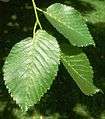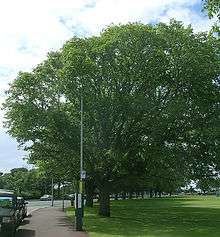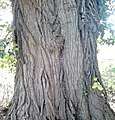''Ulmus'' × ''hollandica'' 'Vegeta'
| Ulmus × hollandica 'Vegeta' | |
|---|---|
|
'Vegeta', Groningen. | |
| Hybrid parentage | U. glabra × U. minor |
| Cultivar | 'Vegeta' |
| Origin | England |
Ulmus × hollandica 'Vegeta', sometimes known as the Huntingdon Elm,[1] is an old English hybrid cultivar raised at Brampton, near Huntingdon, by nurserymen Wood & Ingram in 1746, allegedly from seed collected from an Ulmus × hollandica hybrid at nearby Hinchingbrooke Park.[2][3] The tree was given the epithet 'Vegeta' by Loudon, a name previously accorded the Chichester Elm by Donn, as Loudon considered the two trees identical. The latter is indeed a similar cultivar, but raised much earlier in the 18th century from a tree growing at Chichester Hall, Rawreth in Essex.
Description
In areas unaffected by Dutch elm disease, Huntingdon Elms commonly grow to over 35 m, bearing long, straight branches ascending from a short bole < 4 m in height; the bole of mature trees has distinctive lattice-patterned bark-ridges[4][5] which serve to distinguish the tree from another popular U. × hollandica cultivar 'Major', known as 'Dutch Elm', whose bark breaks into small shallow flakes.[6] The glossy, oval leaves have petioles >10 mm long, which serve to distinguish the tree from the Wych Elm, and are very distinctly asymmetric at the base, < 12 cm long by < 7.5 cm broad contracting to an acuminate apex. A distinguishing feature of Huntingdon Elm is that the leaf margins to right and left of the petiole start from a vein, not from the midrib.[7][8] The leaves are borne on smooth branchlets that never feature corky wings.[9] The tightly-clustered apetalous flowers are bright red, and appear in early spring. The samarae are obovate, < 25 mm long.
Elwes & Henry[3] and Bean[10] attested that the Huntingdon Elm suckers freely, but other writers have stated that it does not sucker at all.[5][11] This contradiction is almost certainly owing to methods of propagation: higher class nurseries grafted cuttings onto Wych Elm stock, which would not produce suckers, whilst others simply rooted the cuttings, which would. A comparatively high percentage of the seed is usually viable.[10]
 Huntingdon Elm leaves; note long petioles. Southsea Common
Huntingdon Elm leaves; note long petioles. Southsea Common._Osney_churchyard%2C_Botley_Road%2C_Oxford_(1).jpg) Huntingdon Elm leaves, Osney churchyard, Botley Road, Oxford
Huntingdon Elm leaves, Osney churchyard, Botley Road, Oxford._Osney_churchyard%2C_Botley_Road%2C_Oxford_(2).jpg) Underside
Underside Huntingdon Elm foliage, North Merchiston Cemetery, Edinburgh
Huntingdon Elm foliage, North Merchiston Cemetery, Edinburgh Huntingdon Elm bark; note lattice pattern
Huntingdon Elm bark; note lattice pattern Bark of 'Vegeta', Inverleith Park, Edinburgh
Bark of 'Vegeta', Inverleith Park, Edinburgh.jpg) Huntingdon samarae, showing seed close to notch
Huntingdon samarae, showing seed close to notch Huntingdon fruiting, The Meadows, Edinburgh
Huntingdon fruiting, The Meadows, Edinburgh
Pests and diseases
The tree was one of four European cultivars found by researchers in The Netherlands to be resistant to the initial strain of Dutch elm disease, Ophiostoma ulmi, prevalent in the 1920s and '30s, the others being 'Monumentalis' Rinz, 'Berardii' and 'Exoniensis'. The four were rated less resistant than U. foliacea clone 23, from Spain, later cultivated as 'Christine Buisman'.[12] 'Vegeta' has, however, only a marginal resistance to the later, three times more lethal strain, Ophiostoma novo-ulmi.
Cultivation
The tree was widely planted in England, particularly between the end of the nineteenth century and the 1930s,[6] owing to its very rapid growth (< 3 m per annum) and attractive wide-spreading form, but its habit of forking sometimes led to splitting of the trunk and premature death. On the continent it was marketed in the late 19th century by the Späth nursery of Berlin as U. vegeta Loud., 'Huntingdon elm',[13] and by the Ulrich nursery of Warsaw as U. montana vegeta,[14] whence it was introduced to Eastern Europe, surviving there in several arboreta. It was introduced to the Dominion Arboretum, Ottawa, Canada in 1893 as U. montana Huntingdoni,[15] and to the USA, appearing as U. vegeta in the 1902 catalogue of the Bobbink and Atkins nursery, Rutherford, New Jersey,[16] as U. Huntingdoni in the 1904 catalogue of Kelsey's, New York,[17] and by the same name in the 1913 catalogue of Plumfield Nursery of Fremont, Nebraska, where it was described as 'one of the finest of this family'.[18] Also introduced to Australasia (to Victoria in 1865[19]), the tree was marketed by several Australian nurseries in the late 19th and early 20th centuries.
Owing to its resistance to the original strain of Dutch elm disease, 'Vegeta' was planted in large numbers across Amsterdam after the Second World War as a replacement for 'Belgica' (Belgian Elm), but was itself eventually replaced by the Dutch cultivar 'Dodoens' following the arrival of the more lethal strain of DED in the early 1970s.[20]
 'Vegeta' in Hove Park, East Sussex
'Vegeta' in Hove Park, East Sussex Wind-pruned Huntingdon Elm, Southsea Common, 2007
Wind-pruned Huntingdon Elm, Southsea Common, 2007 Autumn colours, Charlotte Square, Edinburgh
Autumn colours, Charlotte Square, Edinburgh- Huntingdon Elm, Healesville, Victoria, 2010
 'Vegeta' in Lincoln, 2016
'Vegeta' in Lincoln, 2016
Notable trees
The UK TROBI Champion grew at Higham Ferrers in Northamptonshire, measuring 28 m high by 167 cm d.b.h. in 1999 but was felled in 2014;[21] another at Courteenhall in the same county measured 166 cm d.b.h.. In London, many examples still survive, notably around the Millfields Recreation Ground, the largest measuring 31 m high by 88 cm d.b.h.;[22] others can be found at Hackney, two in Gibson Square, Islington, and one in Westminster known as The Marylebone Elm.[23] Several dozen planted in the 1920s survive on Southsea Common in Portsmouth, isolated from disease by the sea and urban sprawl. Lincoln has five examples on Yarborough Crescent[24] and in Hull there are four on Brunswick Avenue.[25] One tree survives at the foot of Ladies Mile, Bristol.[26] Another elm is located in Sheffield, as a street tree on the corner of Chelsea Road, and known locally as the Chelsea Elm.[27]
In Wales one very large tree (NT number 771, last recorded in 1995) stood in the grounds of Powis Castle, near Welshpool; others have been reported from Abergavenny and Caernarfon. Edinburgh has several of note, in The Meadows and Bruntsfield Links, in Inverleith Park, Fettes College, and Abercromby Place. In Éire, 'Vegeta' is represented by a tree at the Kildangan Stud, Kildangan.
Notable plantings in Australia include the Avenue of Honour in Ballarat, and Brisbane Avenue, Canberra.[28] Mature specimens line the main street in Healesville, Victoria.[29] Some very large specimens survive in New Zealand, notably in Auckland where it is considered "the finest of all the elms" in that city. The 16 trees (now only five) planted in 1922 around the rotunda at Auckland Zoo were described as "magnificent... with stately crowns and spreading, drooping branches".[30][31]
Huntingdon-like cultivars
F1 hybrids between Wych and Field Elm (e.g. Huntingdon Elm) are fully fertile, but produce widely variant progeny.[32] An elm at Magdalen College, Oxford, long believed to be a wych elm, then identified by Elwes as a 'Vegeta'-type hybrid, was for a time the largest elm known in Britain before it was blown down in 1911 (see under U. × hollandica). An old 'Vegeta'-type hybrid (girth 4.5 m) stands (2017) at the University College sports ground, Abingdon Road, Oxford.[33] As neither leaves nor form appear typical Huntingdon Elm, the tree may have arisen from a Huntingdon seedling. Bean noted that hybrids similar to Huntingdon occur naturally in parts of east-central England and may have been raised by nurseries and distributed, and that the raising and distributing of cultivars from the seed of Huntingdon will have produced elms similar to, but not the true Huntingdon clone.[10]
 Old 'Vegeta'-type hybrid, University College sports ground, Abingdon Road, Oxford (2017)
Old 'Vegeta'-type hybrid, University College sports ground, Abingdon Road, Oxford (2017) Bark of University College elm, Oxford
Bark of University College elm, Oxford Autumn leaves of University College elm
Autumn leaves of University College elm U. × hollandica, Gayfield Square, Edinburgh
U. × hollandica, Gayfield Square, Edinburgh Bole of same
Bole of same Leaves of same
Leaves of same
A mature weeping elm survives (2010) near Actons Farm in the vicinity of the Rivers Nursery, Sawbridgeworth, Hertfordshire, which closed in the 1980s. The tree has leaves of similar size to those of the Huntingdon Elm, but slightly oblong in shape, and often either revolute or convolute. The proximity of the Actons tree to the Rivers Nursery would seem more than coincidence, as the nursery was known to have sold seedlings, rather than clones, of the Huntingdon Elm, a practice which resulted in a lawsuit brought by a disgruntled nurseryman at the Oxford Assizes in 1847.[34] Elwes noted that in Hertfordshire and along the western borders of Essex "the most graceful form of this tree [weeping elm] may be seen in perfection", but he identified it as Ulmus nitens (Ulmus minor).[3]
The weeping elm once grown at Kew as 'Wentworthii Pendula' was identified by Melville as U. × vegeta, though its leaf and form differ from those of Huntingdon Elm.
Synonymy
Hybrid cultivars
- 'Commelin'. U.'260' (Ulmus × hollandica × Ulmus pumila) raised at Wageningen but never commercially released; a few specimens survive as part of the Brighton & Hove CC NCCPG Elm Collection at Happy Valley Park, Woodingdean, and at the Wijdemeren City Council Elm collection in The Netherlands, five were planted on the Overmeerseweg and Dammerweg in Nederhorst den Berg in 2015.
Accessions
North America
- Holden Arboretum. Acc. no. 70–128
- Morton Arboretum. Acc. nos. 593–30, 71–70
- New York Botanical Garden. Acc. no. 529/89
- United States National Arboretum, Washington D.C., Acc. no. PI38492
Europe
- Bodnant Garden, Conwy, Wales. No accession details.
- Brighton & Hove City Council, UK, NCCPG Elm Collection
- Hortus Botanicus Nationalis, Salaspils, Latvia. One tree, planted 1998, acc. no. 18127.
- Rainis Park, Liepāja, Latvia. Two trees, planted before 1994.
- Royal Botanic Garden Edinburgh. Acc. no. 19699364
- Westonbirt Arboretum , Tetbury, Glos., UK. Two trees, one without planting date or acc. no., the other planted 2001, acc. no. 1999/118.
- Wijdemeren City Council, Netherlands, Elm Collection. 3 trees planted around 1970 Spiegelweg, Nederhorst den Berg.
Australasia
- Avenue of Honour, Ballarat, Australia. Details not known.
- Box Hill, (central plantation), Victoria, Australia. Details not known.
- Colac Botanic Gardens, Australia. Details not known.
- Eastwoodhill Arboretum , Gisborne, New Zealand. 3 trees, details not known.
- Fawkner Park, South Yarra, Australia. Details not known.
- Kyneton Botanic Gardens, Kyneton, Australia. Details not known.
- Royal Botanic Gardens, Melbourne , Australia
- Waite Arboretum , University of Adelaide, Adelaide, Australia. Acc. no. 336
Nurseries
Australasia
Europe
- Noordplant , Glimmen, Netherlands
References
- ↑ "BSBI List 2007". Botanical Society of Britain and Ireland. Archived from the original (xls) on 2015-01-25. Retrieved 2014-10-17.
- ↑ John Ingram in The Gardeners' Chronicle, 1847, p.507, p.526
- 1 2 3 Elwes, Henry John; Henry, Augustine (1913). The Trees of Great Britain & Ireland. 7. pp. 1879–1882.
- ↑ White, J. & More, D. (2002). Trees of Britain and northern Europe. Cassell, London.
- 1 2 Rackham, Oliver (1976). Trees and Woodland in the British Landscape. J. M. Dent, London.
- 1 2 Hanson, M. W. (1990). Essex elm. London: Essex Field Club. ISBN 978-0-905637-15-0. Retrieved 2017-10-24.
- ↑ Jobling & Mitchell, Field Recognition of British Elms, Forestry Commission Booklet (1974), p.19, fig.33
- ↑ Schneider, Camillo Karl (1906). Illustriertes Handbuch der Laubholzkunde. 1. Jena G. Fischer. p. 215
- ↑ Diagnostic photographs of young and mature Huntingdon elms, "Friends of the Meadows and Bruntsfield Links". Archived from the original on July 14, 2011. Retrieved May 14, 2010.
- 1 2 3 Bean, W. J. (1981). Trees and shrubs hardy in Great Britain, 7th edition. Murray, England.
- ↑ Gurney, R. (1958). Trees of Britain. Faber & Faber, London.
- ↑ "Les Ormes de France" (PDF). Revue de botanique appliquée et d'agriculture coloniale. 22 (254): 441. 1942.
- ↑ Katalog (PDF). 108. Berlin, Germany: L. Späth Baumschulenweg. 1902–1903. pp. 132–133.
- ↑ Ulrich, C. (1894), Katalog Drzew i Krezewow, C. Ulrich, Rok 1893-94, Warszawa
- ↑ Saunders, William; Macoun, William Tyrrell (1899). Catalogue of the trees and shrubs in the arboretum and botanic gardens at the central experimental farm (2 ed.). pp. 74–75.
- ↑ Bobbink and Atkins, Rutherford. N.J. 1902. p. 51.
- ↑ General catalogue, 1904 : choice hardy trees, shrubs, evergreens, roses, herbaceous plants, fruits, etc. New York: Frederick W. Kelsey. 1904. p. 18.
- ↑ Welch, G. L. & Co. Plumfield Nurseries, catalog 1913. Plumfield Nurseries, Fremont, Nebraska.
- ↑ Brookes, Margaret, & Barley, Richard, Plants listed in nursery catalogues in Victoria, 1855-1889 (Ornamental Plant Collection Association, South Yarra, Victoria, 1992), p.303–304
- ↑ amsterdamsebomen.nl
- ↑ "Huntingdon elm felled in Higham Ferrers". 2014.
- ↑ Johnson, O. (2011). Champion Trees of Britain & Ireland, p. 169. Kew Publishing, Kew, London; ISBN 9781842464526.
- ↑ Article on The Marylebone Elm, Trees for Cities web-page
- ↑ "Google Street View - Yarborough Crescent". Google Street View.
- ↑ "Google Street View - Brunswick Avenue". Google Street View.
- ↑ Richard Bland, 'The Downs Observer' in The Bristol Six, March 2016, p.14
- ↑ "Sheffield Huntingdon Elm to get Tree of the Year cash - BBC News". BBC News. Retrieved 2017-06-29.
- ↑ Spencer, R., Hawker, J. and Lumley, P. (1991). Elms in Australia. Australia: Royal Botanic Gardens, Melbourne. ISBN 0-7241-9962-4
- ↑ Spencer, Roger, ed., Horticultural Flora of South-Eastern Australia, Vol. 2 (Sydney, 1995), p.112
- ↑ Auckland Botanical Society Journal (2003). Vol. 58 (1), June 2003. ISSN 0113-4132
- ↑ Photograph of Huntingdon Elm, Point Erin Park, Herne Bay, New Zealand, bts.nzpcn.org.nz
- ↑ Richens, R. H. (1983). Elm. Cambridge University Press.
- ↑ "Google Street View - Sunningwell Road". Google Street View.
- ↑ Ingram, J. (1847). The Huntingdon Elm - Bates v. Rivers. Gardeners' Chronicle, 526.
External links
- Jobling & Mitchell, 'Field Recognition of British Elms', Forestry Commission Booklet
- "Herbarium specimen - L.3712162". Botany catalogues. Naturalis Biodiversity Center. Labelled Ulmus × hollandica 'Vegeta', 1968 [Huntingdon Elm clone]
- "Herbarium specimen - L.1586885". Botany catalogues. Naturalis Biodiversity Center. Cultivated as U. vegeta (RBGE specimen)
- "Herbarium specimen - E00824827". Herbarium Catalogue. Royal Botanic Garden Edinburgh. Cultivated as U. vegeta (RBGE specimen)
- "Herbarium specimen 308706 herbariaunited.org" Sheet labelled Ulmus montana var. vegeta, Weston-super-Mare, Somerset, 1910, A. Ley
- "Herbarium specimen 308705 herbariaunited.org" Sheet labelled Ulmus montana var. vegeta, Kew Gardens specimen, c.1910, A. Ley
- "Herbarium specimen 309311 herbariaunited.org" Sheet labelled Ulmus montana var. vegeta, "Huntingdon Elm", Kew Gardens specimen, 1908, A. Ley